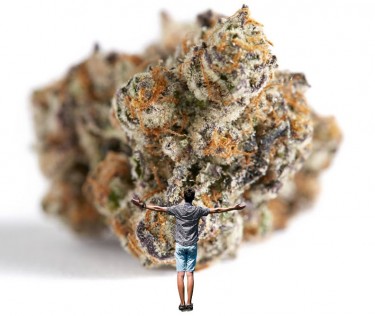
4/20 on Easter Sunday: A Divine Sign to Resurrect the Cannabis Movement?
This Sunday marks a rare celestial alignment—4/20, the unofficial cannabis holiday, falls on Easter Sunday. The last time these two celebrations coincided was in 2014, and before that in 2003. After this year, we'll have to wait until 2087 for this particular convergence to happen again, according to U.S. Census data. While some might chuckle at the cosmic joke of a day celebrating resurrection overlapping with one celebrating getting high, I see something more profound: a symbolic reminder that the cannabis legalization movement itself may need a resurrection.
Despite nationwide polls showing 57% of Americans support legalizing cannabis for both medical and recreational purposes, we're witnessing something unexpected—a legislative pushback against the green wave that has swept across America for the past decade. In state after state, politicians are targeting everything from THC potency limits to tax rates, and some are even attempting to roll back voter-approved programs entirely.
Have we grown complacent? Has the cannabis community mistaken partial victory for total triumph? As we light up this Sunday (if that's your thing), perhaps we should reflect on the work that remains and recommit ourselves to the cause of cannabis freedom—a cause that's as much about personal autonomy as it is about access to a plant.
The Changing Landscape: Progress Under Threat
It's easy to forget that just over a decade ago, no states had legalized recreational cannabis. Today, according to the latest data, 24 states and Washington D.C. allow recreational sales, while 39 states have sanctioned medical marijuana. This rapid expansion created what Penn State's Daniel Mallinson called "an air of inevitability" around legalization.
But that air is growing thinner.
In Idaho, where every neighboring state has legalized cannabis in some form, Republican state Rep. Bruce Skaug has led efforts to impose a mandatory $300 fine for possession and, more alarmingly, to take away voters' right to legalize cannabis through ballot initiatives. The latter measure will appear on Idaho ballots in 2025, potentially removing the most successful pathway to legalization in numerous states.
"Looking around at other states that have legalized marijuana, it's not improved their states as a place to raise a family, to do business," Skaug told Stateline. "It just hasn't come through with the promises that we heard years ago for those states."
This sentiment isn't isolated to deep-red Idaho. Across the country, lawmakers are targeting cannabis through various means:
-
In Montana, legislators have introduced bills to cap THC content at 15% (down from the current 35%) and just passed a measure reducing edible dosage limits from 10mg to 5mg per serving
-
Maryland, Michigan, New Jersey, and Ohio have all considered or implemented significant tax increases on cannabis
-
In South Dakota and Nebraska, legislators have attempted to restrict voter-approved medical marijuana programs
"This year in particular, we're playing defense a lot more than we have in the past," warned Morgan Fox, political director at NORML. The pendulum that swung toward liberalization for a decade may now be swinging back.
Changing Consumption Patterns in Changing Times
As we face this political backlash, it's worth noting how cannabis consumption itself is evolving. According to a recent Centers for Disease Control and Prevention (CDC) report analyzing 2022 data, while smoking remains the most common method (79.4% of users), eating (41.6%), vaping (30.3%), and dabbing (14.6%) cannabis are growing in popularity.
Compared to 2016 data, "the prevalences of eating and vaping marijuana were each higher in 2022," according to the CDC report, "as was the prevalence of reporting multiple routes of use." About half of all adult cannabis users (46.7%) reported multiple methods of consumption.
This diversification of consumption methods reflects cannabis's movement into the mainstream. No longer just the domain of joint-rolling enthusiasts, cannabis appeals to people who prefer the precision dosing of edibles or the discretion of vape pens. The plant's versatility has helped it reach new demographics—but it has also attracted new critics concerned about high-potency products.
Montana state Sen. Greg Hertz, a Republican who sponsored legislation to cap THC levels, put it bluntly: "People were voting for Woodstock weed, not this new high-THC marijuana."
Youth Use: The Fact vs. Fiction
Despite anti-cannabis rhetoric often focusing on protecting children, the data tells a different story about youth consumption in the legalization era. According to CDC reports, as of 2023, about 17% of high-school students reported using marijuana within the past month—down significantly from 23% in 2013, when legal recreational markets were just beginning.
The decline has been particularly pronounced among male students, with rates falling from 25% in 2013 to 15% in 2023. Another report from the Substance Abuse and Mental Health Services Administration (SAMHSA) found that consumption among minors aged 12 to 20 had fallen slightly in the past year, suggesting that youth use has decreased significantly over the past decade—precisely when cannabis legalization was expanding most rapidly.
These findings directly contradict prohibitionist claims that legalization would lead to increased youth consumption. If anything, regulated markets with strict ID verification have made it harder for young people to access cannabis compared to the prohibition era when dealers never checked ID.
Cannabis as a Symbol of Freedom
As we observe both Easter and 4/20 this Sunday, it's worth reflecting on how cannabis has historically represented something more than just a recreational substance. During the counterculture movement of the 1960s and the resistance to the "Just Say No" era of the 1980s, cannabis symbolized rebellion against oppressive authority and the right to cognitive liberty.
Today, as we face new threats to cannabis freedom—from potency caps to confiscatory tax rates—perhaps it's time to reclaim that symbolic power. Cannabis isn't just a consumer product; it's a declaration that adults should have sovereignty over their own consciousness.
Idaho state Rep. Ilana Rubel, a Democrat, highlighted the disconnect between public opinion and legislative action: "I think this is one of those issues where there is just a huge, huge gap between what the people of Idaho want and what they're going to get from their legislature." She noted that a 2022 poll found nearly 70% of Idahoans supported legalizing medical marijuana, yet the state remains firmly prohibitionist.
This democratic deficit—where politicians ignore their constituents' wishes on cannabis—should concern anyone who values representative government, regardless of their personal views on the plant.
The Path Forward: Reigniting the Movement
So how do we resurrect the cannabis movement in the face of this backlash? Here are a few suggestions:
- Stay engaged politically: Don't assume legalization is inevitable. Contact your representatives, register to vote, and support cannabis-friendly candidates.
- Support equitable policies: Push for licensing frameworks that provide opportunities for those harmed by prohibition, not just deep-pocketed corporations.
- Challenge misinformation: When you hear outdated "Reefer Madness" claims, counter them with evidence about falling youth use rates and the safety profile of cannabis compared to legal substances like alcohol.
- Consume responsibly: If you use cannabis, do so in ways that don't reinforce negative stereotypes. The CDC report notes that public health messaging about potential risks of different consumption methods is important—we should acknowledge this while maintaining that adults deserve the right to make informed choices.
- Remember the medical patients: As we fight for recreational access, never forget that many people rely on cannabis for serious medical conditions. Their needs must remain central to the movement.
The calendar alignment of Easter and 4/20 this year feels symbolically significant. Just as Easter represents renewal and resurrection in the Christian tradition, perhaps this 4/20 can mark a renewal of purpose for the cannabis movement.
The fight for cannabis freedom is far from over. Ten years ago, we might have thought legalization was just around the corner nationwide. Now we know better. This plant—which helps millions medically, harms no one when used responsibly, and represents a profound statement about personal liberty—deserves our continued advocacy.
So this Sunday, whether you're hunting eggs, lighting up, or both, take a moment to reflect on the progress we've made and the work that remains. The cannabis movement doesn't need a miracle to succeed—it just needs us to stay vigilant, passionate, and engaged.
The resurrection of our commitment begins now. The next chapter of cannabis freedom is ours to write.







